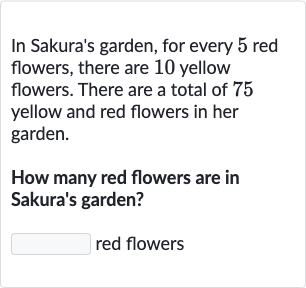Full solution
Q. In Sakura's garden, for every red flowers, there are yellow flowers. There are a total of yellow and red flowers in her garden.How many red flowers are in Sakura's garden?red flowers
- Understanding the Ratio: Understand the ratio of red to yellow flowers and the total number of flowers.Sakura's garden has a ratio of red flowers to yellow flowers. This ratio can be simplified to red flower for every yellow flowers. There are a total of yellow and red flowers in her garden.
- Calculating Total Parts: Calculate the total parts of flowers based on the simplified ratio.Since the ratio is red flower to yellow flowers, there are parts in total ( part red parts yellow).
- Determining the Value of One Part: Determine the value of one part.To find out how many flowers represent one part, we divide the total number of flowers by the total number of parts.Total number of flowers = Total parts = Value of one part = Total number of flowers / Total partsValue of one part = Value of one part =
- Calculating the Number of Red Flowers: Calculate the number of red flowers.Since part represents red flowers, we multiply the value of one part by the number of parts for red flowers.Number of red flowers Value of one part Number of parts for red flowersNumber of red flowers Number of red flowers
More problems from Counting principle
QuestionGet tutor help
QuestionGet tutor help
QuestionGet tutor help
QuestionGet tutor help
QuestionGet tutor help
QuestionGet tutor help
QuestionGet tutor help
QuestionGet tutor help
QuestionGet tutor help

